For many divers photographing Great White Sharks is a “must do” experience. A way of capturing this unique animal’s presence in its own environment. Of which they are truly master of and why they are indeed the apex predator.
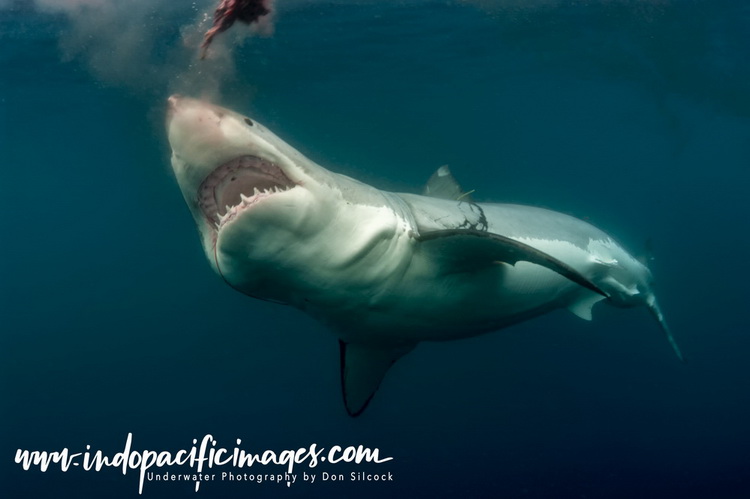
Photographing Great White Sharks – Hard to Find…
Great White Sharks inhabit all the temperate marine waters of the world. But given their relatively small and declining global population and the sheer size of the ocean. The chances of actually seeing one is extremely small. Add to that the fact that if you did see one in the open. You would probably be more concerned with survival than photography. So the probability of obtaining a great image diminishes to almost zero…
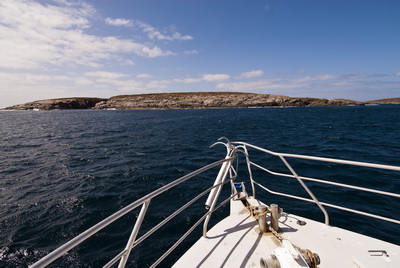
Therefore photographing the Great White Shark means you have to go to them.
And there are currently three main locations where it is possible to see them in the open water.
These are the Neptune Islands to the south of Port Lincoln in South Australia. Dyer Island to the southeast of Capetown in South Africa and the Mexican island of Guadalupe off from Baja California.
All three locations support a large resident colony of seals, the high fat food of choice for Great Whites. Along with a number of companies who offer expeditions to cage dive with the sharks that gather there. A methodology first developed by the Australian husband and wife team of Ron and Valerie Taylor back in the late 1960’s.
My experience is limited to South Australia. But I have done several trips over the last 18 years and enjoyed every one. Even the ones where we saw no sharks, because the whole deal is such a unique experience!
Great White Sharks – Surprisingly Reserved…
It’s a commonly held perception that blood in the water will send any sharks present in to a feeding frenzy. But when you see actually the Great White Shark in the presence of blood. Together with burley and large chunks of “free” tuna. The truth is that they are very cautious in their approach and will cruise past the baits multiple times before they will actually go for it.
White sharks are believed to go for days, possibly weeks, without feeding. Mainly because when they do feed, it’s on high fat creatures such as seals that provide a tremendous source of sustaining energy.
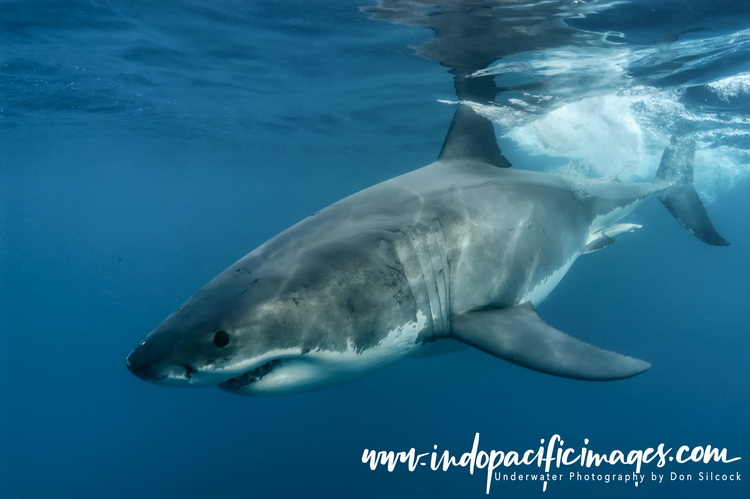 Therefore, while their innate predatory senses bring them towards the source of the tuna oil slick. Whether they actually take the tuna baits seems to be a function of when they last fed. And if that was long enough ago that the shark’s hunger overcomes its caution, it will take the bait.
Therefore, while their innate predatory senses bring them towards the source of the tuna oil slick. Whether they actually take the tuna baits seems to be a function of when they last fed. And if that was long enough ago that the shark’s hunger overcomes its caution, it will take the bait.
If not, the shark’s appear to cruise the area till they have assessed the situation. And then continue their journey – where to, nobody really knows…
The younger sharks are definitely more aggressive and willing to take a risk. They are also the ones that can provide the biggest surprise as they often approach the cage from below. Where you are least expecting them to come from!
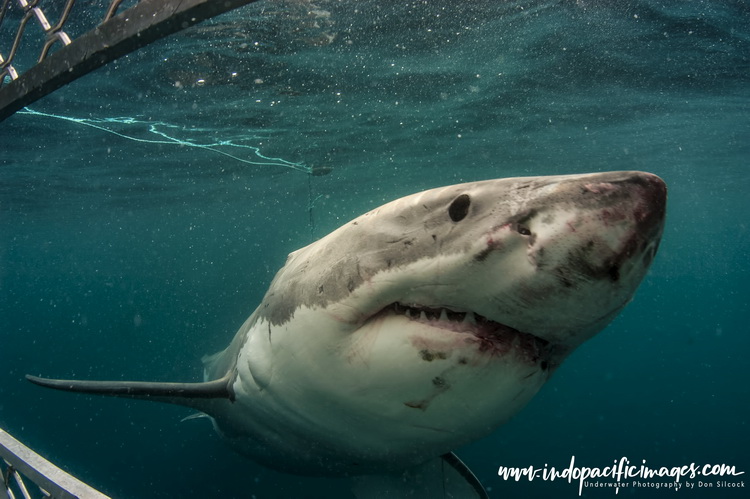
Photographing Great White Sharks – Technique
Technically, photographing the Great White Sharks is a combination of dealing with a fairly fast moving subject in changing ambient light as the shark maneuvers around the cage. Even when the Great Whites are moving slowly, their pace through the water is still quite rapid. And so a high shutter speed is required to freeze that motion and get sharp results.
It’s difficult to use a strobe in the cage. Because you need to be able to poke the housing through the viewing area when the moment is right. But quickly and easily retract it should one of the sharks get too close… Plus with all the blood and burley in the water the strobe would really need to be extended well away from the housing to avoid a lot of backscatter, which would prove to be very cumbersome and difficult to maneuver.
What I found worked the best was to set my camera to matrix metering and shutter priority mode. With a shutter speed of at least 1/250 of a second, and allow the camera to set the aperture automatically. At the time I was using a third generation DSLR technology Nikon D300, with a 6 FPS frame rate. So I was limited to around 400 ISO and all the images on this site were either taken with either that, a D100 or were on film with a F100 – so pretty old tech!

Photographing Great White Sharks – Lenses
The lenses I have used most were the 10.5mm fish-eye on DX and the Sigma 15mm fish-eye on the F100. When the sharks come in they come close and they are big… So you need a really wide lens to get all of their body in the frame. The average great white you will see in South Australia is 3-4m in length. The biggest I have personally seen was a 5m monster – so the fish-eye really is needed!
If I was using my current D500 I would use center-weighted metering, AF-C auto-focus probably set to three-dimensional tracking. Shutter priority at 1/500, 10FPS and auto ISO. For lenses I would use the Nikon 8-15mm plus the Tokina 11-20mm rectilinear zoom.
Photographing Great White Sharks – Composition
I was really disappointed with the film images from my very first trip to South Australia. On almost every image I had cut-off half the shark’s body out of the overall image. But it was not until I did a trip with a DSLR, and was able to review my images while in the cage, that I realized what I was doing wrong.
Underwater, the eye of a Great White appear to be a black and featureless void. It seems to draw you to it automatically, and I realized that I was aiming the camera straight at it and cutting off the body of the shark every time. It’s almost as if the shark is hypnotizing you, so magnetic is the pull of the eye. I had to force myself to concentrate on getting the complete shark in the frame whenever possible.
Physically the challenge is to somehow wedge yourself in position. Allowing you to hold your camera properly whilst keeping your arms & elbows inside the cage. Easier said than done when the cage is bobbing about in the chop. But it’s extremely difficult to compose and get a good shot unless you can master this, however I found the most “comfortable” position was in the corner of the cage with my elbow wedged down inside the grab rails on the inside of the cage.
Photographing Great White Sharks – Full Attack…
The most dramatic shots of the Great White is probably when it’s going for the bait and has switched into it’s “full attack mode”. With it’s snout up, lower jaw depressed & upper jaw extended to expose it’s teeth and gums in a hideous fashion. All to achieve the maximum opening of it’s mouth, so it can seize it’s prey.
This sequence of events has actually been timed at between 0.75 and 1.78 seconds, which combined with the fact that the shark is moving like a speeding train will explain why a camera with 5 FPS frame rate and fast auto-focus is needed.
 Great White Shark Wranglers…
Great White Shark Wranglers…
The key to getting good images is a combination of the technique described above. Plus being in the right position in the cage and a good shark wrangler on the back of the boat! A good wrangler will know exactly how to give photographers the show they are looking for… With the tricky part getting a Great White to cooperate! What happens is that the tuna bait hangs on a float, which attached to a rope. When the shark makes a move towards the bait the wrangler on the boat pulls it towards the cage. Straight towards the waiting photographers.
Sometimes the shark will lazily pursue the bait with mouth half open, looking like it’s considering a quick snack. But if you are lucky a hungry shark will decide that it’s mealtime and really go for it. Often the shark will get the bait before it reaches the cage. Which means the bait is in the image – OK, but not as good as the image without the bait…
If you are really lucky, the shark will go in full attack as the bait is pulled in to your corner. Allowing you to capture the shark really close but without the bait in the image because the wrangler has just pulled it out of the water over the top of the cage.
This is as close as you could get to a Great White in full attack mode and live to tell the tale. A truly adrenaline intensive experience, but there is often even more to come. As the shark sometimes vent its frustration on the cage by biting it and shaking it from side to side. When that happens you truly understand the sheer force these incredible creatures posses and why they truly are the apex predator!
When to Go?
The big question…. There are no guarantees when it comes to seeing the Great White Shark – they grace you with their presence. While the optimum time is from June through to September, they have also been seen regularly in March and April. Sometimes as late as September and October.
The June through to September optimum period is when the seal pups start to feed themselves. Which means that they leave the shelter of the shore and venture out to hunt, making them prime targets for the Great Whites…
The waters of the Spencer Gulf are cold… Temperatures of 18-20 deg C (64-68 deg F) are common in summer. In winter the water goes down to around 14 (57) degrees, so a dry suit is highly recommended.
Back To: Complete Guide to Australian Great Whites

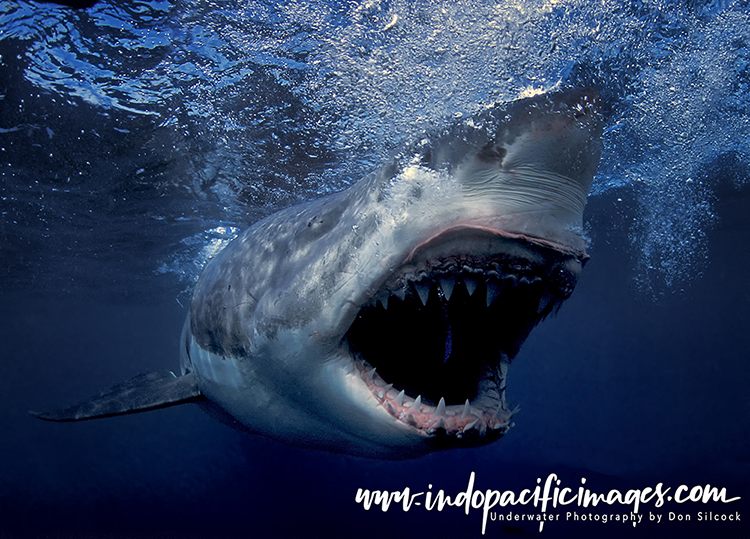 Great White Shark Wranglers…
Great White Shark Wranglers…